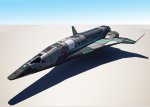I have just uploaded Starship Sizes: Changing the Assumptions to the downloads area.
I was writing this for EONS magazine, but it turned out I only needed one page and that does not an EONS article make. So here it is for free!
This is just draft; I have NOT playtested this. it is designed to accommodate different assumptions in starship size while still allowing you to use the Starship Construction Manual. Any comments are welcome.
This makes it a lot easier to build Traveller sized starships or WH40K sized starships, instead of the default Trek-ish scale. You could choose to make all ships use a certain scale, all allow all three scales in your settings. This essentially changes the tonnage range to a lower end of 10 tons up to an upper end of ... well as high as you want to go, really.
The rules are meant to be simple and easy to apply. To build a small ship, simply build a standard one and then apply the adjustments.
You can find the file here in the downloads section. Please use this thread for comments.
I was writing this for EONS magazine, but it turned out I only needed one page and that does not an EONS article make. So here it is for free!
This is just draft; I have NOT playtested this. it is designed to accommodate different assumptions in starship size while still allowing you to use the Starship Construction Manual. Any comments are welcome.
This makes it a lot easier to build Traveller sized starships or WH40K sized starships, instead of the default Trek-ish scale. You could choose to make all ships use a certain scale, all allow all three scales in your settings. This essentially changes the tonnage range to a lower end of 10 tons up to an upper end of ... well as high as you want to go, really.
The rules are meant to be simple and easy to apply. To build a small ship, simply build a standard one and then apply the adjustments.
You can find the file here in the downloads section. Please use this thread for comments.


